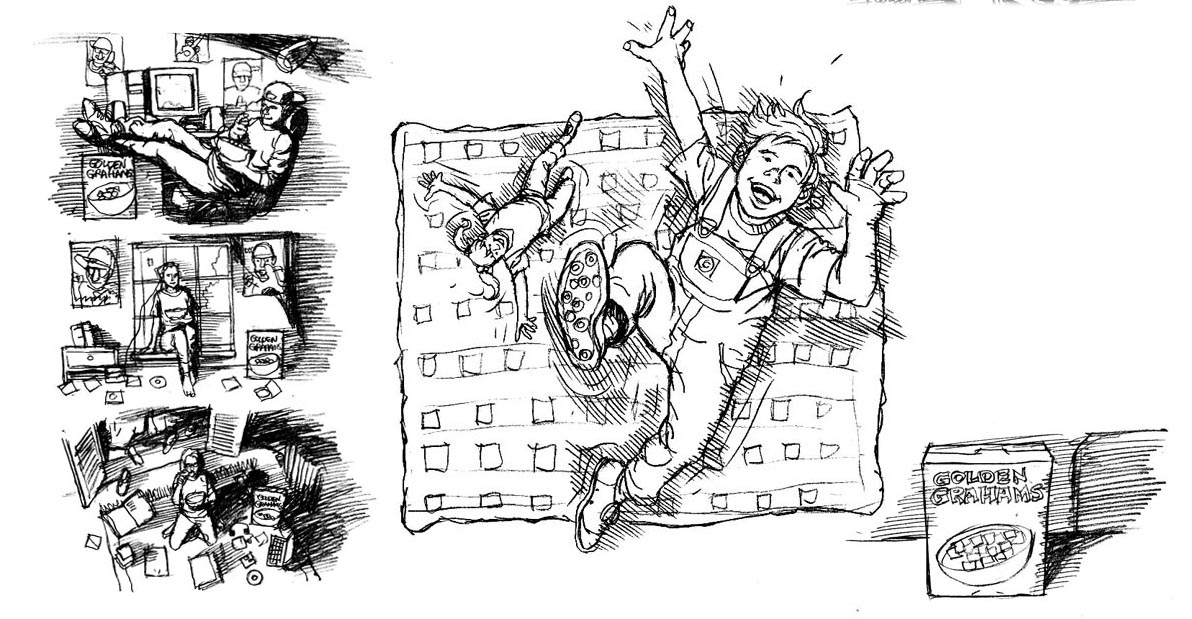I loved drawing and telling stories with my drawings, so it was perfect for me. My first actual "job" was a staff job at Della Femina advertising in 1982. It got my feet wet, and I learned about how fast you had to work to meet deadlines. Most of the jobs in those days were done in 3 steps... pencil, ink, color... which is the way pretty much everyone worked.

Then in the early 90's some agencies I worked for wanted only pencils, which they would xerox very darkly. I was thrilled working this way, because my work became more spontaneous and I began experimenting with color techniques, like mixing prismacolor pencils over the marker, as well as watercolors.
In those days I mainly used a #2 MONGOL PENCIL -- remember those? They don't make them for the U.S. market anymore, although I think you can special order them. I believe they are now sold in the Philipines.

These days I've been using a soft mechanical pencil. Anyway, here's a bunch of samples of my later storyboard style which is more "sketchy" and "spontanious" than tight. I think this way of working is great for storyboarding, because it's clear, tells the story, and can be done fairly quickly. Also,you can lightly pencil background figures to make them "recede" back.

In SVA I also had 2 storyboard teachers: Dick Naugler and Hy Rosen. Hy Rosen worked at Y&R and had a comics background in the 1950's working on I Love Lucy comics. He was a great guy to learn from. I was also fortunate to work with one of the top storyboard artists in the business, Ken Bald. I worked with him in the mid 80's at Gem Studio (which was basically a sweat shop) but it was worth it because I learned a huge amount working from Ken - and my friend Vince Musacchia.

Ken also had worked in comics in the 40's and 50's,and done "Dr. Kildare" and "Dark Shadows" syndicated comics strips...he also did many finished illustration projects...he was a tremendous influence on my storyboard work.
*Many thanks, Brian, for sharing your story and these terrific examples with us! If you'd like to tell us a bit about your career doing storyboards, drop me a line at the email address in the sidebar and I'll send you a guest author invite - or send your story along some examples of your work and I'll post it on your behalf.
I really like these penciled boards Brian. Great drawing, very clear with plenty of life! Nice.
ReplyDeleteThank you Brian for the in depth information you have provided. I too wish to become an artist for Comics (DC or Marvel), however, my interest in movies and production background has me interesting in Storyboarding as well.
ReplyDeleteI have a question, what are your thoughts on Storyboards or even Comics being created in software instead of paper first. For example, do you use or have any cons about Storyboard Pro? I am asking this because, I need to know what to train on (aside from practicing drawing and photoshop everyday) to give me an edge in getting hired with a company doing Storyboarding.
Thanks Brian,
-Martin
Martin, I've only done hand drawn boards ,and then snanned them to deliverer them digitally....best, Brian.
ReplyDelete